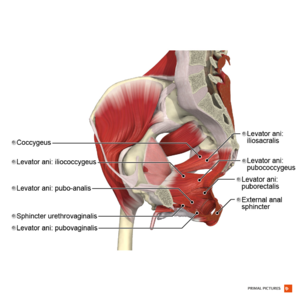Coccygeus
Original Editor - Innocent Abugu
Top Contributors - Innocent Abugu and Kim Jackson
Description[edit | edit source]
Coccygeus also known as ischiococcygeus is a triangular-shaped sheet of muscle located posterior to the levator ani muscles in the pelvic floor. The coccygeus, together with the levator ani, forms the pelvic diaphragm.
Origin[edit | edit source]
It originates from the ischial spine.
Insertion[edit | edit source]
The lateral aspect of the coccyx and the sacrum, along the sacrospinous ligament.[1]
Nerve[edit | edit source]
The anterior rami of S4 an S5.
Artery[edit | edit source]
Internal pudendal and inferior gluteal artery.
Function[edit | edit source]
- It supports the pelvic viscera.
- It flexes the coccyx.
- It weakly aids the puborectalis to control urination an defecation especially when there is an increase in intra-abdominal pressure.
Clinical relevance[edit | edit source]
The pelvic floor muscles (PFM), which consist of the levator ani and coccygeus muscles, are crucial for supporting pelvic organs[2]. Disorder of the pelvic floor muscles would result in pelvic organ prolapse and urinary incontinence.
Assessment[edit | edit source]
To evaluate the activity of the pelvic floor muscles including the coccygeus, the coccygeal movement test is done. This involves the palpation of the coccyx bone. The coccygeal movement test is a simple, objective and non-invasive test used for adequate localization of the pelvic floor muscles.[3] It is done to know if a woman can appropriately identify and contract her pelvic floor muscles.
Treatment[edit | edit source]
Pelvic floor muscle training, also known as Kegel exercises which are performed by repeatedly contracting and relaxing the muscles of the pelvic floor made up of the levator ani and coccygeus muscle.[4]
Resources[edit | edit source]
- ↑ Chaudhry SR, Hulaibi FA, Nahian A, Chaudhry K. Anatomy, Abdomen and Pelvis, Pelvis. StatPearls [Internet]. 2020 May 24. StatPearls Publishing LLC.
- ↑ Huang YC, Chang KV. Kegel Exercises. InStatPearls [Internet] 2020 Apr 7. StatPearls Publishing.
- ↑ Stensgaard SH, Bek KM, Ismail KM. Coccygeal movement test: an objective, non-invasive test for localization of the pelvic floor muscles in healthy women. Medical Principles and Practice. 2014;23(4):318-22.
- ↑ Gowda SN, Bordoni B. Anatomy, Abdomen and Pelvis, Levator Ani Muscle. InStatPearls [Internet] 2020 Mar 27. StatPearls Publishing.







